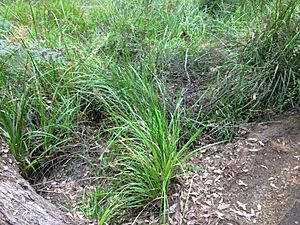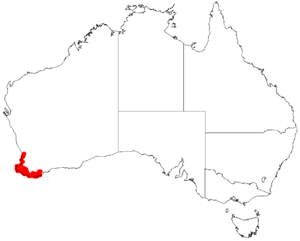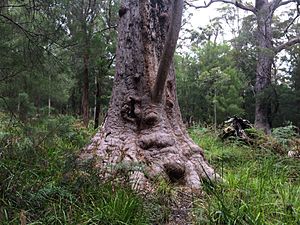Riverside sword sedge facts for kids
Lepidosperma effusum, also known as the riverside sword sedge or spreading sword sedge, is a type of plant that stays green all year round. It is a sedge, which is a grass-like plant often found in wet places. This plant is native to the southwest part of Western Australia.
Quick facts for kids Lepidosperma effusum |
|
|---|---|
 |
|
| Lepidosperma effusum in Walpole-Nornalup National Park | |
| Scientific classification | |
| Genus: |
Lepidosperma
|
| Species: |
effusum
|
 |
|
| Occurrence data from AVH | |

Contents
What is Lepidosperma effusum Like?
This sedge grows in strong, thick clumps. It can reach about 2.5 meters (8 feet) tall and spread out to 2 meters (6.5 feet) wide. It has underground stems called rhizomes, which help it spread. You will only find this plant in wet areas. It produces brown flowers between April and November.
How Scientists Name Plants
The scientific name for this plant, Lepidosperma effusum, was first officially described in 1878. An English botanist named George Bentham gave it this name in his book Flora Australiensis. Scientists use special naming systems to help everyone know exactly which plant they are talking about.
Where Does This Sedge Grow?
You can find the riverside sword sedge growing along the edges of creeks and streams. It also likes to grow around swamps. Its home stretches from the Perth area, south through the Margaret River region, and east towards Albany. It prefers to grow in sandy or loamy soils.
Animals and Plants That Live with the Sedge
Lepidosperma effusum is very important to many animals and other plants. It likes to grow in wet places, just like some other Lepidosperma species.
- Quokkas use the sedge as a safe place to hide.
- Birds like the Noisy scrub-bird, Australasian bittern, and Red-winged fairy-wren often make their nests from its leaves.
- Frogs, such as the Nornalup frog (Geocrinia lutea) and Karri frog (Geocrinia rosea), can be heard calling from inside the sedge clumps.
- Certain moths, including Elachista flavicilia, Elachista effusi, and Elachista strictifica, use the plant as a host. This means they live on it and get food from it.
- A rare spider called Main's assassin spider (Zephyrarchaea mainae) lives in the leaf litter found in the top parts of L. effusum and another sedge, L. gladiatum.
Growing Your Own Sedge
Lepidosperma effusum is sold in plant nurseries. You can grow it in a spot that gets full sun or partial sun. It can even handle a little bit of frost. If you don't have a garden, you can grow it in large ceramic pots.
Why This Sedge is Important
Like many sedges, Lepidosperma effusum plays a big role in keeping wetlands healthy.
- Cleaning Water: Its roots spread out just below the surface. These roots help to clean the water in wetlands.
- Stopping Erosion: The roots also hold the soil together. This stops the soil from washing away, which is called erosion.
- Trapping Run-off: The sedge grows in thick groups along the edges of water bodies. These groups act like a filter, trapping soil and water that runs off the land. This helps to stop too many nutrients from getting into the water.
- Storing Nutrients: The plant can store a lot of nutrients in its stems and underground roots. This helps to keep the water clean. Bacteria on its roots also help to change nutrients and other pollutants.
This species can grow in areas with fresh water or slightly salty water, known as brackish water.

